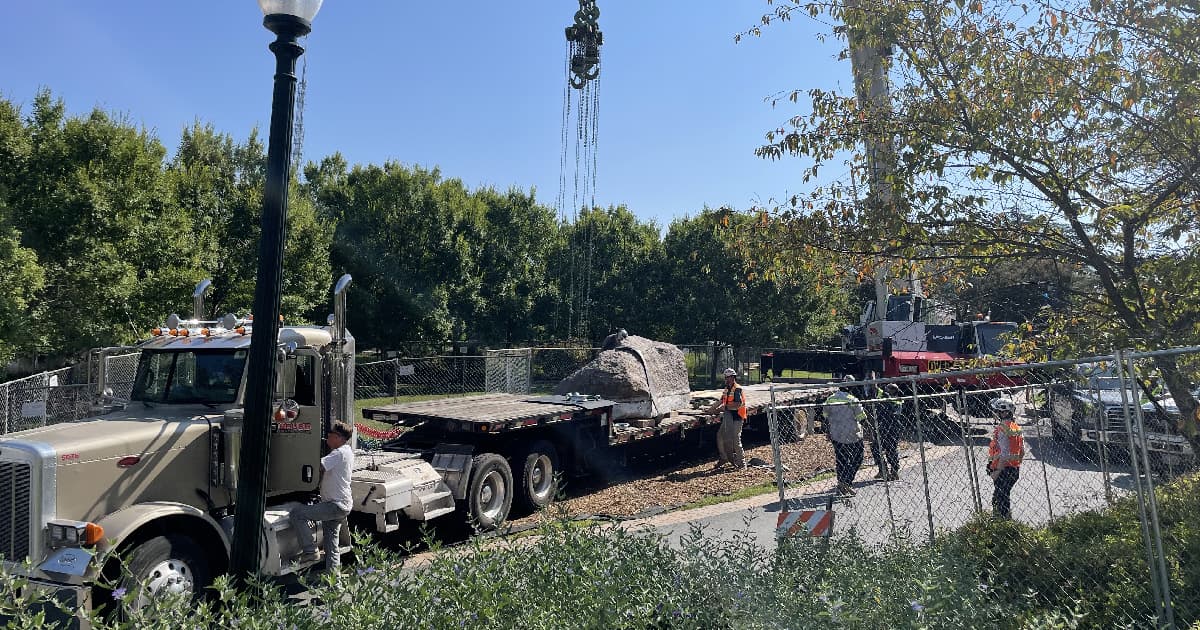Moving Mountains: More than 225 Tons of Boulders Find Home at AU

A truck carrying boulders weighing nearly the same as 40 grown elephants made trips from downtown DC along Massachusetts Avenue in September in a unique sight for onlookers.
Ten boulders, weighing 450,000 pounds or 225 tons, destined for American University’s campus weren’t for landscaping, at least not the traditional kind. The boulders comprise sculptor Elyn Zimmerman’s Marabar, an art installation which has stood at the National Geographic Society downtown since 1984. The rock-and-water sculpture will become a permanent fixture on AU’s campus after completion next year.
The move gives Marabar a second lease on life, as the NGS’ initial plans to relocate the installation to make way for a new entrance pavilion were met with objections from the Cultural Landscape Foundation, a DC-based nonprofit. “Save Marabar” advocacy efforts also included letters from more than two-dozen architects, art critics, and museum leaders to the city’s Historic Preservation Review Board. After two years of negotiations, an agreement was reached to select American University as the sculpture’s new home. The art exhibit is a gift to AU from NGS, who will pay for the move.
The NGS and AU obtained permits this past summer from the DC Department of Transportation to make the move. Cranes at NGS lifted each boulder onto a low-slung flatbed trailer truck that would bring them one at a time to the AU campus. Cranes also were installed at AU to receive the boulders, place them in a staging area next to the Kay Spiritual Center and ultimately be arranged in their final location in the ellipse along Massachusetts Avenue.
The challenge was to transport the massive split-rock, red granite boulders of varying dimensions from their downtown 17th Street NW location to AU with minimal disruption to the neighborhoods and commuters along the way.
On the morning of September 19, the first boulder was placed onto the flatbed truck and driven on the DDOT-approved nearly four-mile route starting at 17th Street NW, proceeding to M Street, then on to 18th Street and Connecticut Avenue, through Dupont Circle, and north on Massachusetts Avenue. Once the boulder arrived at Glover Gate on the AU campus, workers crane-lifted the boulder off the flatbed and placed it in the staging area.

“Our initial plan was to move one boulder a day. However, things progressed smoothly enough that some days we actually transported multiple boulders and managed to complete the entire move ahead of schedule in about a week and a half,” said Max Wnorowski of Davis Construction, the construction manager for NGS.
Prior to the arrival of the boulders, the telecommunications infrastructure that runs underground beneath the installation’s proposed location was encased using two truckloads of concrete to protect it from the weight of the installation. Additional concrete also was laid to serve as the foundation for the sculptures, and water lines were run from Kogod to supply the installation’s reflecting pool.
“While Marabar is a technically simpler project than many others on the university campus, like the recently completed Hall of Science, it had implementation challenges like any other. It is exciting to be a part of a different sort of project, adding to the aesthetic of the university landscape,” said Tony Cortés, project manager for AU.
Due to its placement in the ellipse, the installation will be reimagined and configured differently from how it was at the NGS. The engineers have worked closely with Zimmerman to ensure that the installation is true to her artistic vision and meets with her approval.

In the month since the move, five accent boulders already have been placed in their permanent location and, in the coming weeks, the five main sculpture boulders are expected to be installed as well. Pavers also will be installed around the installation’s perimeter.
Jack Rasmussen, director of art gallery and curator of the AU Museum currently is working with Zimmerman to create an official exhibit to showcase the installation.
Marabar was given to AU during the Change Can’t Wait campaign which creates transformative educational opportunities, advances research with impact, and builds stronger communities.
Editor’s note: This story has been corrected to reflect that Marabar was never in danger of being demolished and that advocacy efforts from The Cultural Landscape Foundation were to preserve Marabar at NGS. It has also been updated to correct the number of boulders and their weight, which is 10 boulders weighing 450,000 pounds.
